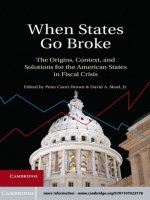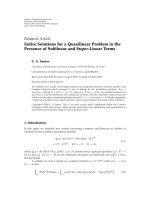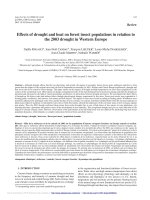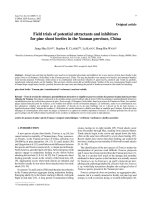When States Go Broke The Origins, Context, and Solutions for the American States in Fiscal Crisis ppt
Bạn đang xem bản rút gọn của tài liệu. Xem và tải ngay bản đầy đủ của tài liệu tại đây (3.11 MB, 342 trang )
When States Go Broke collects insights and analyses from leading academics and
practitioners who discuss the ongoing scal crisis among the American states. No
one disagrees with the idea that the states face enormous political and scal chal-
lenges. There is, however, little consensus on how to x the perennial problems
associated with these challenges. This volume lls an important gap in the dialogue
by offering an academic analysis of the many issues broached by these debates.
Leading scholars in bankruptcy, constitutional law, labor law, history, political
science, and economics have individually contributed their assessments of the
origins, context, and potential solutions for the states in crisis. It presents readers –
academics, policymakers, and concerned citizens alike – with the resources to begin
and continue that important, solution-oriented conversation.
Peter Conti-Brown is an Academic Fellow at the Rock Center for Corporate
Governance at Stanford Law School and the Stanford Graduate School of
Business. His research focuses on banking regulation and nancial and s-
cal crises, and includes articles published in the Stanford Law Review, UCLA
Law Review, and the Washington University Law Review, among other law
journals.
David A. Skeel, Jr., is the S. Samuel Arsht Professor of Corporate Law at the
University of Pennsylvania Law School. He is the author of The New Financial
Deal: Understanding the Dodd-Frank Act and Its (Unintended) Consequences
(), Icarus in the Boardroom (), and Debt’s Dominion: A History of
Bankruptcy Law in America (), as well as coeditor with Michael Klarman
and Carol Steiker of The Political Heart of Criminal Procedure (), a collection
of tribute essays to William J. Stuntz.
When States Go Broke
, ,
Peter Conti-Brown
Rock Center for Corporate Governance
Stanford University
David A. Skeel, Jr.
University of Pennsylvania School of Law
Edited by
Cambridge, New York, Melbourne, Madrid, Cape Town,
Singapore, São Paulo, Delhi, Mexico City
Cambridge University Press
Avenue of the Americas, New York, -,
www.cambridge.org
Information on this title: www.cambridge.org/
© Cambridge University Press
This publication is in copyright. Subject to statutory exception
and to the provisions of relevant collective licensing agreements,
no reproduction of any part may take place without the written
permission of Cambridge University Press.
First published
Printed in the United States of America
A catalog record for this publication is available from the British Library.
Library of Congress Cataloging in Publication data
When states go broke : the origins, context, and solutions for the American states in
scal crisis / [edited by] Peter Conti-Brown, David Skeel.
p. cm.
Includes bibliographical references and index.
---- (hardback)
. State government bankruptcy – United States. . Finance, Public – United
States – States. I. Conti-Brown, Peter, – II. Skeel, David A., –
.
′.–dc
---- Hardback
Cambridge University Press has no responsibility for the persistence or accuracy of s
for external or third-party Internet Web sites referred to in this publication and does not
guarantee that any content on such Web sites is, or will remain, accurate or appropriate.
v
Contents
List of gures page vii
List of tables ix
List of contributors xi
Acknowledgments xiii
Introduction: The Perennial Crisis for the American
States
-
PART I. THE ORIGINS OF THE STATES IN
FISCAL CRISIS
Fiscal Institutions and Fiscal Crises
-
Obligations Without the Power to Fund Them
.
Public Pension Pressures in the United States
.
Structural Challenges in State Budgeting
PART II. THE LEGAL AND POLITICAL CONTEXT
OF PUBLIC DEBT
What States Can Learn From Municipal Insolvency
.
Contentsvi
Market Discipline and U.S. Federalism
American States and Sovereign Debt Restructuring
PART III. EVALUATING SOLUTIONS
State Bankruptcy from the Ground Up
. , .
Fiscal Federalism and the Limits of Bankruptcy
.
Extending Bankruptcy Law to States
.
Bankruptcy For the States and By the States
Labor and the States’ Fiscal Problems
Epilogue – David A. Skeel, Jr.
Index
vii
Figures
. Adoption of rst constitutional debt restrictions,
by decade page
. Number of states that have a constitutional debt
restriction, by decade
. Adoption of rst constitutional BBR, by decade
. Number of states that have a constitutional BBR,
by decade
. Number of adoptions of RDFs, by decade
. Number of state rainy day funds, by decade
and type
. Limits on traditional TELs and property tax
limitations, by decade of rst adoption
. Number of states that have traditional TELs and
property tax limits, by decade
. Adoption of constitutional scal institutions
. Number of states that had adopted each type of
constitutional scal institution, by decade
. Anticipated year of exhaustion for state pension
fund assets
. Pie chart of state and local tax sources in
. Graph of pupil-teacher ratios and education
spending as a share of GDP over time
. The growth of federal grants relative to state and
local current expenditures
. Credit default swaps for selected U.S. states
. Credit default swaps for selected U.S. states and member
states of the European Monetary Union
List of guresviii
. Debt-to-GDP ratios for European countries and U.S. states
. Unadjusted Hourly Compensation – Public and Private
Sector Compared:
. Adjusted Hourly Compensation – Public and Private Sector
Compared:
. Public Pension Plan Funding Ratios by Extent of Collective
Bargaining Rights: Fiscal Year
. Median Budget Gap by Extent of Collective Bargaining
Rights: Fiscal Year
. Median Budget Gaps by Extent of Collective Bargaining
Rights, Fiscal Years –
. Median State Workforce as a Percentage of Total Workforce
by Extent of Collective Bargaining Rights:
. Median State Labor Expense as a Percentage of State Budget
by Extent of Collective Bargaining Rights: Fiscal Year
ix
Tables
. Government revenues as a share of GDP page
. Government debt as a percentage of GDP
. Hypothetical Budgets
. Present value of aggregate state dened benet plan
liabilities, alternative scenarios
. Year of public plan exhaustion for alternative asset returns,
under ongoing and termination scenarios
xi
Josh Barro is the Walter B. Wriston Fellow at the Manhattan Institute for
Policy Research, where he specializes in state and local scal policy. He
received his AB from Harvard College.
Peter Conti-Brown is an Academic Fellow at the Rock Center for Cor-
porate Governance at Stanford Law School and the Stanford Graduate
School of Business. He writes in the areas of banking, bankruptcy, cor-
porate, and administrative law, with a particular focus on the law, eco-
nomics, and history of nancial and scal crises, public and private debt
regulation, and central banking. He is a graduate of Stanford Law School
and Harvard College.
Adam Feibelman is the Sumter Davis Marks Professor of Business and
Corporate Law at Tulane Law School where he researches and writes on
banking, bankruptcy, and sovereign debt.
Catherine Fisk is the Chancellor’s Professor of Law at the University of
California, Irvine. She is the author of three books and dozens of articles
on labor law. She received a JD from the University of California, Berke-
ley, and an AB from Princeton University.
Clayton P. Gillette is the Max E. Greenberg Professor of Contract Law
at NYU School of Law, where he teaches in the areas of state and local
government law and commercial law.
Adam J. Levitin is a Professor of Law at Georgetown University Law
Center where he specializes in bankruptcy, commercial law, and nancial
regulation. He received his JD from Harvard Law School.
Michael W. McConnell is the Richard & Frances Mallery Professor of Law
and Director of the Constitutional Law Center at Stanford Law School
Contributors
List of contributorsxii
and Senior Fellow at the Hoover Institution. He was previously a Circuit
Judge on the United States Court of Appeals for the Tenth Circuit.
Olivia S. Mitchell is the International Foundation of Employee Benet
Plans Professor at the Wharton School of Business at the University of
Pennsylvania and a Research Associate at the National Bureau of Eco-
nomic Research. Her research focuses on the economics and public policy
of private and public pensions. She received an MA and PhD in Econom-
ics from the University of Wisconsin-Madison, and an AB in Economics
from Harvard University.
Brian Olney is a JD candidate at the University of California, Irvine, and
received a BA from Wesleyan University. From to he worked
for the Service Employees International Union, focusing on health care.
Jonathan Rodden is Professor of Political Science and W. Glenn Campbell
and Rita Ricardo-Campbell National Fellow at the Hoover Institution,
Stanford University. He is the author of Hamilton’s Paradox: The Prom-
ise and Peril of Fiscal Federalism.
Isabel Rodriguez-Tejedo is a professor in the Department of Economics
at the University of Navarra (Spain). She received her PhD in Economics
from the University of Maryland.
Damon A. Silvers is the Director of Policy and Special Counsel for the
AFL-CIO and has served in various local, state, and federal government
capacities, including as the Deputy Chair of the Congressional Oversight
Panel for TARP from to . He received a JD, MBA, and AB, all
with honors, from Harvard University.
David A. Skeel, Jr., is the S. Samuel Arsht Professor of Corporate Law at
the University of Pennsylvania Law School. He is the author of The New
Financial Deal: Understanding the Dodd-Frank Act and Its (Unintended)
Consequences (), Icarus in the Boardroom (), and Debt’s Do-
minion: A History of Bankruptcy Law in America (), as well coeditor
with Michael Klarman and Carol Steiker of The Political Heart of Crimi-
nal Procedure (), a collection of tribute essays to William J. Stuntz.
George Triantis is Professor of Law at Stanford Law School. Prior to
joining the Stanford Law School faculty in he was the Eli Goldston
Professor of Law at Harvard Law School. He specializes in bankruptcy,
contracts, and corporate law.
John Joseph Wallis is Professor of Economics at the University of Maryland
and Research Associate at the National Bureau of Economic Research.
xiii
Acknowledgments
This book began as a conference at Stanford University, in May .
We thank Dan Siciliano and Rock Center for Corporate Governance at
Stanford University, Michael McConnell at the Constitutional Law Center
at Stanford Law School, and Dean Larry Kramer for generous support for
the conference, and we thank also the many participants for those helpful
discussions. Our thanks also to Trish Gertridge and her staff for making
the conference come to pass.
We also thank Blair Hodges for his work on the index and John Berger
and his staff at Cambridge University Press for excellent editing.
Introduction: The Perennial Crisis
for the American States
-
In the summer of , people throughout the world watched with rapt
attention as Republican leaders in the U.S. Congress and President Barack
Obama squared off against each other in a high-stakes, down-to-the-wire
negotiation over the fate of the country’s ability to issue new debt to fund its
many nancial obligations. The so-called debt ceiling debate illustrated the
toxicity and potency of political-scal brinkmanship. Eventually, the crisis
was averted – or at least forestalled – as a compromise was reached, new debt
issued, and the tarnished credit of the United States relatively unbroken.
In light of the attention paid to the political theater that preceded rais-
ing the debt ceiling, many citizens would be forgiven in thinking that the
United States exists as a sole economic entity for the purposes of scal
policy. This, of course, is erroneous. The several states of America indepen-
dently participate as debtors to a vast array of creditors, from their own
employees to the anonymous masses of the bond markets; from targeted
lenders to the recipients of the states’ safety nets. And while Congress and
the President engaged in a time-consuming game of political chicken dur-
ing the summer of , a phenomenon as central to the American system
as federalism itself continues to y under the radar: The American states, in
their individual governmental capacities, are in extraordinary debt.
Although the states’ debt problems are not, at present, reported above
the fold in leading national newspapers, they persist with a relentlessness
that academics, policymakers, and citizens should heed. The unique his-
tory, context, and structure of the American states in debt require hard and
careful thinking, planning, and action.
Although Standard & Poor’s did downgrade the U.S. credit for the rst time in the credit
rating agency’s history, markets have continued to treat U.S. debt as among the safest
available.
Conti-Brown
This volume gathers some of the leading scholars and commentators
on issues relating to state debt crises to provide that level of thoughtful
engagement not otherwise available in a single volume. These academics
and practitioners from a variety of disciplines and backgrounds address
this basic quandary: How do we understand and navigate the reality that
state governments, by all accounts, appear unable to meet their obligations
to their many claimants, from employees in the form of wages, pensions,
and health care; citizens, in the form of welfare spending, infrastructure,
education, and nearly every other government service; investors, in the
form of general and specic debt; and indeed, any other individual or insti-
tution who interacts with state governments? At stake in this crisis is the
very essence of state government, with the difcult and highly contested
questions of what state governments ought to be, what state governments
presently are, and how any difference between the two can be bridged in a
contentious political climate.
Although frequently riding backseat to the more pressing concerns of
sovereign – especially the United States – scal woes, nearly everything
about the question of states’ scal crises is fraught with urgency and con-
troversy. In alone, tens of thousands of protesters lled the streets in
Madison, Wisconsin, to challenge or support that state’s efforts to rede-
ne its relationship to its public employees’ unions; legislators in Indiana
absconded out of state with hopes to avoid votes on controversial issues
on similar matters; the state of California began for a time paying its credi-
tors with IOUs because the state was simply unfunded; Mayor Bloomberg
of New York City proposed to lay off thousands of teachers in an already
stretched school district to bridge the gap left by state cuts in Albany. And
in a recent report, it was determined that the country of Iraq enjoys a
higher credit rating than the state of Illinois.
What, then, might be done about these crises? Are federal bailouts of the
states political nonstarters or predetermined by the nature of our union? Is
serious tax reform a frank and inevitable necessity or so politically toxic as
to be dismissed out of hand? Are unions’ collective bargaining rights driv-
ing the states over a precipice, or are unions nothing but tangential gures
in this story, paraded out as easy scapegoats by politicians eager to avoid
the harder issues at stake? Would a mechanism for states to restructure
their debts, similar to bankruptcy, resolve the problem or make it worse?
Is such a mechanism even possible as a matter of law, or, for that matter,
politics? What can we learn from the experiences of other public entities
who have engaged in debt restructuring, whether foreign sovereigns or
municipalities?
Introduction
The authors who have contributed to this volume address these and
related questions. The authors, taken together, agree on very little. Some
consider the rhetoric of the conversation in general and even the title of
the book overblown. Others think the problems are far graver than this
Introduction has described. All authors, however, contribute to some aspect
of this conversation and inform readers, challenge conventional thinking,
and encourage those who seek to understand these problems to dig deeper
than they have already done to understand what, exactly, is the problem in
the American states today, and, as importantly, how it can be resolved.
The book is organized, as its subtitle suggests, into three subsections:
origins, context, and solutions. In the rst section, ve scholars provide
essentially a historical context for the states’ problems, each highlighting
different elements of the issues faced. Economic historians John Wallis and
Isabel Rodriguez-Tejedo discuss, in illuminating detail, the ways in which
states over the last two centuries have responded to scal crises and eval-
uate the current state of the states against that historical backdrop. Olivia
Mitchell, the leading economist studying private and public pensions, pro-
vides a thorough introduction to the nature of state pensions and the ways
in which funding commitments can create ballooning liabilities when the
assumptions undergirding those commitments change. The Manhattan
Institute’s Josh Barro contributes a chapter on the basic mechanics of
state budgetary processes. And Damon Silvers, former Deputy Chair of
the Congressional Oversight Panel and present Director of Policy for the
AFL-CIO, takes a fundamentally different tack, laying the problems fac-
ing the states at the feet of the political and economic changes that states
have experienced over the last thirty years. Silvers highlights in particular
two phenomena. First, the changing nature of recessions, from those that
were steep, deep, relatively short-lived, and related to the business cycle,
to those that are long, shallow, and the consequence of nancial crises.
Second, Silvers analyzes the ways in which New Federalism, championed
by President Ronald Reagan and his supporters and extended during sub-
sequent Administrations, takes from the federal government the respon-
sibility of massive welfare provision and gives that responsibility to the
states – a responsibility they are not always best situated to bear.
In the second section, we learn more about how insolvency regimes
have functioned elsewhere in the world and elsewhere in the United States.
In his contribution to the volume, Clayton Gillette, a leading scholar of
both local and state government law and commercial law, leads readers
through the context of municipal bankruptcy, comparing and contrasting
the relatively well-established system of municipal bankruptcy with the
Conti-Brown
problem of state insolvency. In the process, he discusses how the funda-
mentally different relationship between states and the nation on the one
hand versus states and their subentities on the other complicates, perhaps
irretrievably, the ways in which the solutions for municipal bankruptcy
can be made applicable to the problems of state debt.
Of course, cities and states are not the only political entities that face debt
crises, as the events in the United States and especially Europe throughout
can amply attest. In this sense, Adam Feibelman, a scholar of bank-
ruptcy and sovereign debt, ably introduces the history and implications of
the regimes currently in place to allow sovereigns to restructure their debts
in times of crisis. Feibelman’s detailed case studies of sovereign default
will be of interest to those readers interested in how, specically, resolving
sovereign debt crises can – and cannot – compare to the debt crises facing
the states.
Political scientist Jonathan Rodden performs a similar analysis but
focuses instead on the theoretical structure of scal federalism, a topic he
has reinvigorated over the last decade. Rodden views the basic problem
of scal federalism through the familiar lens of moral hazard in that sub-
national entities may attempt to displace their debts to the national sov-
ereign, thus avoiding the costs of their debts, both economic and political.
Rodden also helpfully compares the structure of the U.S. states to other s-
cal federations, most relevantly the European Union, itself in a more acute
scal-federalist crisis than the United States has yet faced.
In the nal section of the book, the authors explore, in some detail,
a proposal to allow states to restructure their debts in a process akin to
bankruptcy. David Skeel, the volume’s co-editor and the leading academic
proponent of the proposal, lays out – with specicity not presented in his
other writing on this topic – the strong case for bankruptcy and responds
to many criticisms that have been lodged against the proposal. The three
authors that follow Skeel do not make much of the bankruptcy proposal.
Adam Levitin argues, for example, that the problem facing states is not
nancial, but political, and as a consequence, state bankruptcy proposals
are solutions looking for a specic problem. Michael McConnell, former
federal appellate judge and leading constitutional law scholar, is, for the
purposes of the volume, expressly agnostic as to the policy benets of state
bankruptcy. He does, however, explain the very real constitutional prob-
lems that these proposals face, problems not addressed by making state
bankruptcy a voluntary procedure.
George Triantis, another leading bankruptcy and commercial law
scholar, presents a middle ground. He argues that the concept of a single
Introduction
state bankruptcy regime belies the political, institutional, and nancial
variation that exists among states. He argues instead that states should
pass, themselves restructuring regimes that are more tailored to their own
economic and political realities, and that such proposals should be evalu-
ated on their own bases, with reference to the states that pass them.
Finally, stepping out of the context of state bankruptcy, labor law schol-
ars Catherine Fisk and Brian Olney present the case that public unions
have been a scapegoat in this process and present a sensible alternative to
the widely adopted argument that states need only throw the unions out
in order to resolve their crises. Fisk and Olney discuss how labor law – as
opposed to bankruptcy law – can help resolve the state debt crises. David
Skeel concludes the volume with an epilogue on the state of the states, and
the relevance of this project extends beyond the political zeitgeist of any
single moment.
This book expends signicant energy on assessing the strengths and
weaknesses of state bankruptcy proposals. But the book is not about state
bankruptcy per se, but something far broader, and more important. The
American states face a perennial scal crisis, made painfully obvious each
time recession devastates the economy. To quote one of Warren Buffett’s
perhaps overused nuggets of axiomatic wisdom, “You only nd out who
is swimming naked when the tide goes out.” Because of a combination of
political, scal, and economic factors, the states are chronically swimming
naked. This book represents an effort to understand the basic structure
of this perennial problem, and, hopefully, point toward mechanisms that
would mitigate the problems when they arise.









